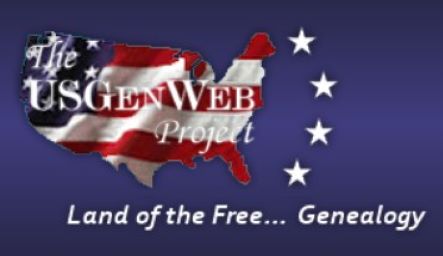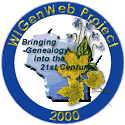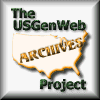

 |
Green Lake County Wisconsin USGenWeb |
 |
 |
Manchester is located
in the center of the county east and west, and on its southern border. It is
bounded on the north by Marquette and Green Lake, on the east by Mackford, on
the south by Columbia County and on the west by Columbia County and the town
of Kingston. Lake Maria cuts into the town near its southeast corner, and the
large Kingston mill pond on its western border north of its center. Grant (Grand?)
River flows westwardly through the town and receives through a swale the overflow
from Lake Maria at times of high water, that lake having no outlet at other
times. This town is quite equally divided into openings-timber timber (sic)
openings, prairie and marsh lands. The East Branch of the Fox River heads in
the southwest corner of this town. The surface of the town is undulating. The
soil is strong in the eastern and central parts, growing lighter and more sandy
towards the West.
Settlement.
The first settler in the town was an old soldier name McGee, who located on
the Henry Vinz farm. He built the first log house and broke up land first in
his neighborhood. This was in 1837. R. Langdon came in 1843, Sawyer Carter,
W.R. Carter, Norman Stewart, James Carter, Madison Miller and Robert Robinson
came in 1844. In 1845 S.W. Matthews, A. Barlow, David Jones, Lucius Clark, Walter
Burlingame, J. Teal, and J. Stickles came. Mr. Miller brought with him some
1,500 sheep, but soon lost most of them by misfortune and mismanagement. Messrs.
Barlow and Mathews had no families and were strangers to each other, but they
pooled their means and endeavors and built and occupied a log shanty together.
The nearest grist-mill in the early days was at Waupun, but the settlers often
had to go to Watertown or to Janesville, eight miles, the nearer mill frequently
making them wait a week for their grists, while the millers ground their own
grain and compelled them to buy their flour or wait longer than they could afford
for their own. In those days a man could get for flour what money would not
command. A. Miner built the sawmill at the village of Manchester in 1847. Dr.
Hoyt laid out the village and built a flouring-mill in 1853. the first school
was opened in 1847. The first church organized was by the Methodists the same
year, the Rev. Mr. Welcome, pastor. The Rev. G.W. Freeman organized the Baptist
Society in 1860. The first white child born in the town was born in McGee's
family. The first marriage was that of a Mr. Bates to Miss Margaret Stalker,
daughter of Joseph Stalker. The first death was that of a child of Mr. Stewart.
The town of Manchester was organized in 1849, with A. Barlow as Chairman of the Board of Supervisors; J. Stalker and H. A. Millard associates, and M.B. Lathrop, Clerk. At one of the early elections a sugar bowl was made to serve as a ballot box.
In the southwest corner of the town is a good-sized German settlement; there is also a Welsh settlement in the town.
The village of Manchester is prettily situated on high land nearly in the center of the town, and has a population of about 300. It was laid out in 1857 by E.R. Hoyt, and is eighteen miles southwest of Dartford, and three miles southwest of Markesan, the nearest railway point. Grant (Grand?) River furnishes a good water-power.
W.A. Millard was probably the first
settle on the village site and arrived in 1846. He was long a Justice of the
Peace. M. Seward built a sawmill there in 1847, which was later superseded by
a flouring-mill of good capacity. Mr. Seward built the first frame house in
1857; the first store was opened by Dr. E.R. Hoyt, the founder of the village,
in 1856. Thirty years ago the place contained two stores, one shoe store, a
blacksmith-shop, a tin-shop, a wagon-shop, a school, a post-office and a gristmill.
The present business men are: john E. Wiselvinca, proprietor of flour mill;
Fogel Wolfgang, dealer in farm implements; George C. Rhein, harness-maker; William
Elliott, dealer in live stock; A.M. Houke and Louis Klatt, shoemakers; V.E.
Babcock and F. Schwandt, carpenters.
Back to GreenLakeCoWI Home Page
GreenLakeCoWI Coordinator: MAKtranscriber WIGenWeb State Coordinator: Tina Vickery WIGenWeb Assistant State Coordinator: Marcia Ann Kuehl
Complication Copyright 1996-Present - by The WIGenWeb Project Team